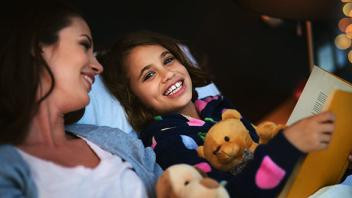There’s a reason we learn nursery rhymes as young children. They help us develop an ear for our language. Rhyme and rhythm highlight the sounds and syllables in words. And understanding sounds and syllables helps kids learn to read!
Activities for younger children
- Create word families. Use refrigerator magnets to spell a word ending (-ap). Have your child put other letters in front of the word ending to create rhyming words (tap, cap, map, lap).
- Fill in the blank. Read children’s poems aloud and leave off the final word, having your child fill in the missing rhyming word:
“Run, run, as fast as you can,
You can’t catch me, I’m the gingerbread ____.” - Make TV time a time for learning. Choose programs with a focus on reading. Check out PBS’ Between the Lions, for children ages 4-7, or Reading Rainbow, for ages 4-8.
Activities for older children
- Write a swap poem. You write one line of a poem, and have your child write the next line, matching the rhythm, and rhyming the last word. (Hint: Use words that are easy to rhyme!)
- Create a rhyming dictionary. Have a page for –op words, and –end words, and –ing words, and –oat words, and then move on to more complex letter patterns like –ouble (trouble, double).
- If kids don’t like reading, try poetry! Poems are short, provide important practice with reading fluency, and give reluctant readers a sense of accomplishment.
Some good poetry books for kids
- Sing to the Sun, by Ashley Bryan
- In the Eyes of a Cat: Japanese Poetry, by Demi
- This Big Sky, by Pat Mora
- The Random House Book of Poetry for Children, edited by Jack Prelutsky
- A Child’s Garden of Verses, by Robert Louis Stevenson
- Any book by Dr. Seuss!
Download this article in Spanish
Subscribe to Growing Readers!
Get our free monthly parent tips — in English and Spanish — delivered right to your inbox!
Reprints
You are welcome to print copies or republish materials for non-commercial use as long as credit is given to Reading Rockets and the author(s). For commercial use, please contact info@readingrockets.org.
